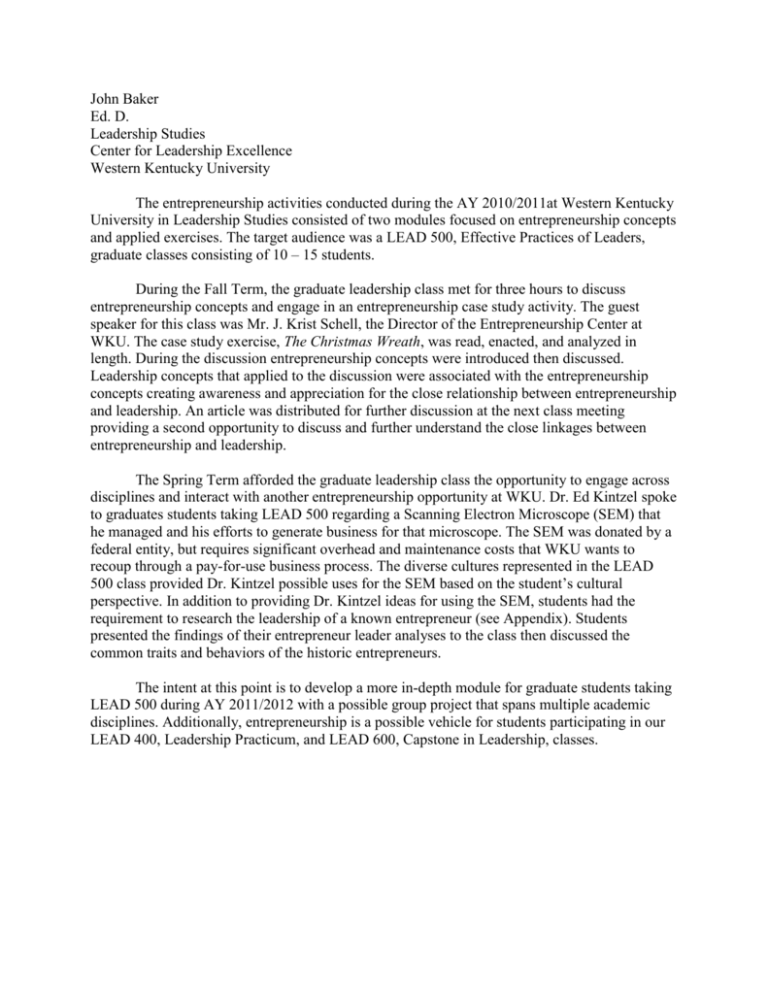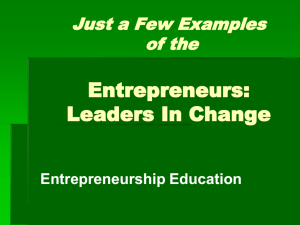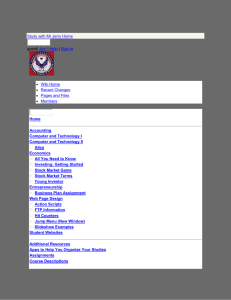The entrepreneurship activities conducted during
advertisement

John Baker Ed. D. Leadership Studies Center for Leadership Excellence Western Kentucky University The entrepreneurship activities conducted during the AY 2010/2011at Western Kentucky University in Leadership Studies consisted of two modules focused on entrepreneurship concepts and applied exercises. The target audience was a LEAD 500, Effective Practices of Leaders, graduate classes consisting of 10 – 15 students. During the Fall Term, the graduate leadership class met for three hours to discuss entrepreneurship concepts and engage in an entrepreneurship case study activity. The guest speaker for this class was Mr. J. Krist Schell, the Director of the Entrepreneurship Center at WKU. The case study exercise, The Christmas Wreath, was read, enacted, and analyzed in length. During the discussion entrepreneurship concepts were introduced then discussed. Leadership concepts that applied to the discussion were associated with the entrepreneurship concepts creating awareness and appreciation for the close relationship between entrepreneurship and leadership. An article was distributed for further discussion at the next class meeting providing a second opportunity to discuss and further understand the close linkages between entrepreneurship and leadership. The Spring Term afforded the graduate leadership class the opportunity to engage across disciplines and interact with another entrepreneurship opportunity at WKU. Dr. Ed Kintzel spoke to graduates students taking LEAD 500 regarding a Scanning Electron Microscope (SEM) that he managed and his efforts to generate business for that microscope. The SEM was donated by a federal entity, but requires significant overhead and maintenance costs that WKU wants to recoup through a pay-for-use business process. The diverse cultures represented in the LEAD 500 class provided Dr. Kintzel possible uses for the SEM based on the student’s cultural perspective. In addition to providing Dr. Kintzel ideas for using the SEM, students had the requirement to research the leadership of a known entrepreneur (see Appendix). Students presented the findings of their entrepreneur leader analyses to the class then discussed the common traits and behaviors of the historic entrepreneurs. The intent at this point is to develop a more in-depth module for graduate students taking LEAD 500 during AY 2011/2012 with a possible group project that spans multiple academic disciplines. Additionally, entrepreneurship is a possible vehicle for students participating in our LEAD 400, Leadership Practicum, and LEAD 600, Capstone in Leadership, classes. APPENDIX Andrew Carnegie (b. 1835, d. 1919) Student:____ ______________________ The Scottish immigrant and weaver's son built a steel empire whose mills churned out the railroads, ships, and structures of post-Civil War America—and created a fortune for himself in the process. Carnegie's quick adoption of the Bessemer process and other techniques to efficiently refine steel enabled him to lower costs and undercut his competitors. After he sold his steel business to J.P. Morgan for $480 million at the start of the 20th century, Carnegie devoted his life and his wealth to endowing institutions that would let other poor sons of weavers better themselves. His "Gospel of Wealth" became a model for future entrepreneursturned-philanthropists like Bill Gates. Key takeaway: Recognizing the innovations that will catalyze an industry means the difference between shutting down the competition and getting shut down. John Jacob Astor (b. 1763, d. 1848) Student:___________________________ The German immigrant came to New York in poverty at age 20 and built a near-monopoly in the global fur trade, founding a trading post at the mouth of the Columbia River, and trading as far as Russia and China. In the 1830s, Astor poured his fur profits into New York real estate, when he saw that demand for land in and around Manhattan would only increase. The income from the rents and the value of the land combined to make Astor the wealthiest American of his time. Key takeaway: Astor built on one successful enterprise by investing the profits into another. John D. Rockefeller (b. 1839, d. 1937) Student:__________________________ Rockefeller started his first business selling grain and other goods before he was 20. He turned to oil a few years after it was discovered in western Pennsylvania in 1859. By buying out refineries around Cleveland and New York after the Civil War, Rockefeller soon dominated the market. Vertical integration was key: His company made its own oil barrels and owned storage and shipping facilities. Although Standard Oil was later broken up under antitrust laws, Rockefeller had created a modern industry. He stepped back from the business in 1896 to devote himself to philanthropy, endowing the University of Chicago and the Rockefeller Foundation. Key takeaway: Rockefeller used economies of scale and vertical integration to modernize an industry. Milton Hershey (b. 1857, d. 1945) Student:__________________________ The man whose name would mean chocolate actually got his start in caramel. But in 1905, Hershey built the world's largest chocolate factory in Pennsylvania and developed a model town around it. Mass production turned an exclusive luxury good into something that could be sold to a mass market. He developed a recipe for milk chocolate himself based on his close study of European candymaking. Hershey also opened a sugar plant in Cuba during World War I to protect his supply chain from shortages in Europe. As a philanthropist, he endowed many local groups in the town that bears his name, including a school for orphans. Key takeaway: Hershey created an iconic product at a price that let millions enjoy what once had been reserved for the wealthy. Selling "low-cost luxury" became a viable business model. Henry Ford (b. 1863, d. 1947) Student:__________________________ Ford did not invent the automobile, but he made it affordable to the middle class that he helped create. His assembly lines produced inexpensive cars, and he paid the workers on those lines enough to buy the products they made. Ford sold 15 million Model Ts between 1908 and 1927. The availability of cheap autos drove demand to build the road infrastructure that made America a nation of drivers. Ford was far from perfect—his anti-Semitism is well-documented—and the company lost ground to rivals like General Motors in his later years. But his manufacturing process created the modern car industry, and with it, the car culture of the 20th century. Key takeaway: Ford made a product once considered a luxury available to a mass market by transforming the manufacturing process. Ray Kroc (b. 1902, d. 1984) Student:__________________________ Ray Kroc turned a California burger shack into a brand whose golden arches span the globe. By investing in franchisees rather than squeezing them for profits, Kroc drove the inexorable growth of McDonald's and created one of the most visible brands in history. He put McDonald's longterm growth ahead of making quick cash off new owners, focusing each on his pillars of "quality, service, cleanliness, and value" so that customers had a uniform experience of the McDonald's brand. Key takeaway: Taking the long view rewarded Kroc, even though he might have made more money earlier by milking his franchisees. Entrepreneurs who invest in the long-term growth of their businesses at the cost of short-term profits can look to him as an example. Madam C.J. Walker (b. 1867, d. 1919) Student:__________________________ Born the daughter of former Louisiana slaves and orphaned at age 7, Walker developed a homemade scalp lotion to stop her hair loss. She then turned her remedy into a business—and a movement. Walker's line of hair-and-beauty products geared toward blacks tapped into a market ignored by other businesses because of racism. She also used her clout and fortune to advocate for change, pushing for anti-lynching laws and contributing to civil rights causes. She set an example for generations of entrepreneurs in a time when women were still struggling for voting rights and Brown v. Board of Education was a half-century away. Key takeaway: The era's ingrained racism left a huge part of the population underserved by the market. Walker profited by making them her customers. Estée Lauder (b. 1907, d. 2004) Student:__________________________ Young Estée Lauder, born Josephine Esther Mentzer to immigrant parents in the Corona, Queens section of New York City, began experimenting as a child with skin treatments her uncle cooked up. In 1946, she founded the company that bears her name to sell makeup and perfume in highend department stores around the world. Lauder's business philosophy centered on selling products she considered to be of the highest quality, and she used her products themselves as advertisements. Lauder pioneered giving free samples at stores like Saks Fifth Avenue to hook customers. Although Lauder died in 2004, her grandson William still runs the company, with more than 9,000 products and $6.5 billion in sales in 2006. Key takeaway: Lauder became a giant in the nascent beauty industry by making sure the quality of her products exceeded the expectations of her target market, namely wealthy society women. Earl Graves (b. 1935) Student:__________________________ Earl Graves, a Brooklynite, Green Beret, and former aide to Senator Robert Kennedy, founded Black Enterprise magazine in 1970. His publication both recognized the expanding financial power of the black community and helped spur its growth. Black Enterprise now boasts a paid circulation of half a million and has been profitable since its 10th issue. Graves also ran the $60 million Washington (D.C.)-area Pepsi-Cola franchise from 1990 to 1998. At the time, it was the largest minority-owned Pepsi franchise in the U.S. Graves remains active in Pepsi. His best-selling book, How to Succeed in Business Without Being White (1997), provides a framework for black professionals and business owners based on Graves' own life. Key takeaway: The civil rights movement aimed to achieve equality under the law, but the struggle for equal economic opportunity goes on today. It's a fight Graves continues to lead. Muhammad Yunus (b. 1940) Student:__________________________ Yunus, the 2006 Nobel Peace Prize winner, founded a banking system 30 years ago to lend small amounts of money to the rural poor in Bangladeshi villages. Most of the low-interest microloans go to women, who use them to start their own profit-making enterprises, mainly in agriculture, crafts, or services. Grameen Bank now has 2,422 branches, employs more than 20,000 people, and has loaned more than $6 billion since its founding. Borrowers own most of the equity in the bank. The company has been profitable in all but three years since it was founded. Key takeaway: Yunus imagined what would happen if a bank extended credit to those people who would never traditionally receive it. In the process, he created a system that empowered the poor by helping them become entrepreneurs. Martha Stewart (b. 1941) Student:__________________________ The onetime stockbroker started a catering business out of her Westport (Conn.) home in 1976. Stewart went on to expand into retail, publishing, television, and merchandising. Her umbrella company, Martha Stewart Living Omnimedia, was formed in 1996 to be just what its name implied—a way to market her lifestyle brand and products across media. The five months Stewart spent in prison after being convicted of lying about her sale of ImClone stock may turn out to be just a small stain on her career, one she surely could find the right home remedy to remove. Key takeaway: Stewart profited by making her name into an attractive lifestyle brand. Azim Premji (b. 1945) Student:__________________________ Premji inherited his father's struggling food oil business when he was a 21-year-old student at Stanford University. Now that business, Wipro, is one of the leading IT companies in India and a growing player in the global market. After making the company profitable and expanding from food oil to other consumer goods, Premji led Wipro into the nascent tech economy in the 1970s. He put a premium on quality and standards to build a reputation for Wipro that would reassure Western companies hesitant to move services overseas, a move that helped him land clients like General Electric. Premji is also a hands-on manager involved in day-to-day operations, even making sales calls himself. Key takeaway: Premji built a leading IT company as the industry was growing and he expanded into the global market by adhering to rigorous standards.








